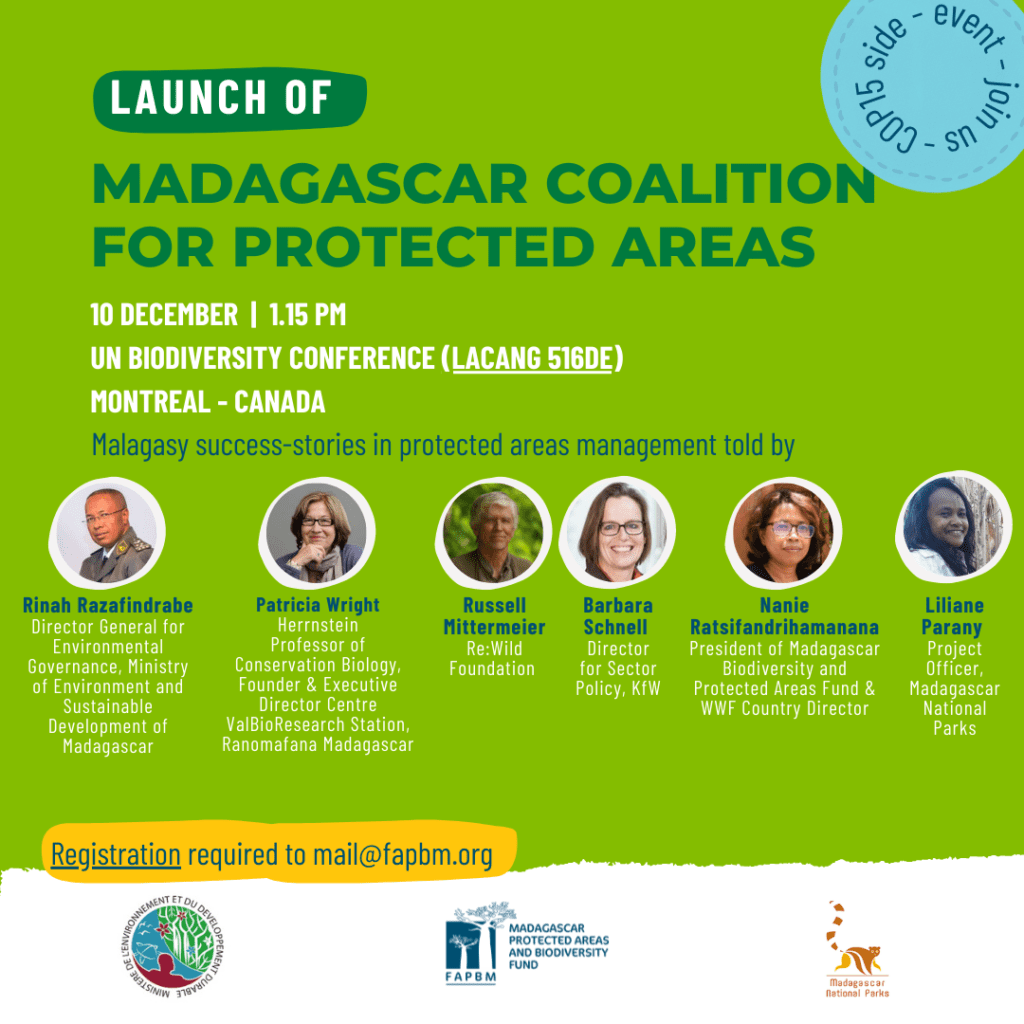
Montréal, December 10, 2022 – Today the Madagascar Ministry of Environment and Sustainable Development launched the Madagascar Coalition for Protected Areas during a well-attended side-event of the COP15 UN Biodiversity Conference.
Madagascar has 123 Protected Areas across the nation, in the right places that are worth protecting as they represent the country’s biological diversity, natural heritage, and provide nature-based solutions to sustainable economic development needs of the country.
From the 2003 Durban vision of tripling Madagascar’s protected areas to the 2014 Sydney pledge to strengthen marine protected areas, the Madagascar government and non-government organizations have worked on creating and managing the system of parks and reserves across the nation. Supported by mostly international donors, thousands of competent, dedicated local experts, working tirelessly with local communities and the beneficiary impacts are starting to show in some of the protected areas. These success stories provide critical insights in how protection of ecosystems generates multiple benefits for the nation and indeed the planet.
“As several of the protected areas in Madagascar start to evidence multiple benefits for our people and the planet, we are pleased that our very capable conservation actors are aligning efforts to efficiently expand the level of effort and resources across all 123 protected areas in the country.” stressed Mr. Rinah Razafindrabe, Director General of Environmental Gouvernance, as the representative of the Ministry of Environment and Sustainable Development, Mrs Marie-Orléa Vina, during his introduction speech.
Unfortunately, as the economic status of Madagascar continues a downward trend, Madagascar’s conservation organizations are increasingly challenged in their efforts to help implement protected area management across the nation. This has provided strong arguments to build a strong coalition capable of driving twenty-first century change towards integrating conservation with economic development.
Madagascar has nearly everything it needs to implement its number one strategy to protect biodiversity. All that is required now, is to amass adequate financial resources and political will to enable magnification of success across the entire system of all 123 protected areas in the country. This will be the shared goal of the new Coalition for Madagascar Protected Areas.
“What do we do? We secure long-term financing through two partner, FAPBM […] Madagascar National Parks […]. We are very motivated to continue to work with this partner because they show very high level of commitment and also have improved their performance significantly […]We are very big supporters of the coalition for protected areas, it is a great initiative to bring together national and international friends of Madagascar and we are very happy to be part of this initiative and make our contribution.” This was the call-to-action from Mrs Barbara Schnell, KfW Director of sector policy, sent towards donors.
Starting with the COP15 of the CBD in Montreal, the Ministry, together with several members of the Coalition will profile the value of investing in Madagascar’s protected areas as agents-of-change for poverty alleviation of local communities and sustainable development of local and regional economies.

About Madagascar Coalition for protected areas
The Consortium is a trusted platform for collaboration, implementing solutions for Madagascar’s needs through management of Protected Areas – the agents-of-change.
One of the coalition partners is Madagascar National Parks (MNP), an association under Malagasy law for the purpose of public utility that received a mandate from the State in 1991 to manage the 43 protected areas that existed in Madagascar at the time. Another is the Madagascar Protected Areas and Biodiversity Fund (FAPBM), a Malagasy private trust fund dedicated to the conservation of Madagascar’s biodiversity. There are also a significant number of local and international NGOs whose strategic efforts contribute significantly to the management of protected areas.
Starting in 2023, different organizations will progressively align communication efforts behind a new narrative to significantly enhance the support of donors and other audiences. Through support by KfW, senior leaders and communication experts of members of the coalition will be facilitated to succeed and increase financial and policy support for all 123 protected areas in the protected areas system of Madagascar.
Starting in the first quarter of 2023, joint efforts for mobilization of financial resources will be implemented, so that the achievement of different goals for each member in the coalition can be accelerated efficiently. Through coordination of FAPBM&MNP, a fundraising campaign will be implemented during 2023-2025.
About Madagascar’s strategy to protect biodiversity
Madagascar, the world’s 4rth largest island, has an extremely high wildlife species diversity and hosts many different types of ecosystems and landscapes. Madagascar’s biodiversity represents 5% of the world’s biodiversity.
Recognizing the importance to safeguard biodiverse areas, the Madagascar government has created a protected areas system that is made up of 123 protected areas covering 6,233,317 ha of terrestrial and 1,379,029 ha of marine (including intertidal) ecosystems. An in-progress project is working on tripling marine protected areas before 2026. This protected area system is the country’s greatest natural capital asset and has been described as a ‘priceless national treasure’ and of ‘immeasurable national and global value’ as both a national and global good.
Unfortunately, effective management of the protected area system is challenged. Within Madagascar, several regions face challenges in sustainable development and protected areas are seen as barriers to growth. Despite a portfolio of significant funding for Madagascar’s protected areas, self-financing the network of currently 123 protected areas is still a major challenge. The COVID-19 pandemic aggravated this situation with the loss of tourism revenues, an increase in pressures due to reduced economic output, and an evolution of the migration of people from the southern parts of the country. The contribution of these places to offset impacts of climate change and to support sustainable economic regional growth is at risk.





